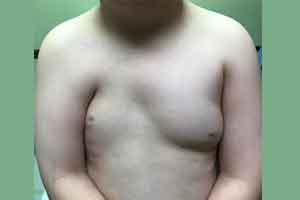- Home
- Editorial
- News
- Practice Guidelines
- Anesthesiology Guidelines
- Cancer Guidelines
- Cardiac Sciences Guidelines
- Critical Care Guidelines
- Dentistry Guidelines
- Dermatology Guidelines
- Diabetes and Endo Guidelines
- Diagnostics Guidelines
- ENT Guidelines
- Featured Practice Guidelines
- Gastroenterology Guidelines
- Geriatrics Guidelines
- Medicine Guidelines
- Nephrology Guidelines
- Neurosciences Guidelines
- Obs and Gynae Guidelines
- Ophthalmology Guidelines
- Orthopaedics Guidelines
- Paediatrics Guidelines
- Psychiatry Guidelines
- Pulmonology Guidelines
- Radiology Guidelines
- Surgery Guidelines
- Urology Guidelines
Case presentation of Poland Syndrome in 8-yr-old boy

Poland's syndrome is a rare congenital condition, characterized by the absence of the sternal or breastbone portion of the pectoralis major muscle, which may be associated with the absence of nearby musculoskeletal structures. The case was reported by Dr. Chandra Madhur Sharma appears in the Indian Journal of Human Genetics.
An 8-year-old school boy presented with a flattening of the left anterior chest wall along with hypoplasia and syndactyly of fingers of the left hand since birth. There was no family history of any congenital disorder.
On examination, a child was of average built, weighing 27 kg and having a height of 129 cm. Arm span was 122 cm, right side contributing 65 cm and left 57 cm. Others vital were within normal limit. His chest was asymmetrical with hypoplasia of the left side and absence of left anterior axillary fold.
The limbs were asymmetrical, left upper limb was short but had a muscle power 4/5 at all the joints. Ipsilateral fingers were short and webbed (symbrachydactyly). Plain skiagram of the chest showed no abnormalities of the ribs or heart but increased lucency over the left side due to the absence of pectoralis major muscle. Axial computed tomography scan revealed the presence of pectoralis major on the right side but not on the left. X-ray of the affected limb demonstrated hypoplasia of the middle and terminal phalanx along with syndactyly. Echocardiography and abdominal ultrasound were normal. Based on above-mentioned anomalies, diagnosis of Poland syndrome was established.
Poland syndrome, so named by Patrick Clarkson in 1962 after observing the similarity of his three cases with the one, described by Sir Alfred Poland in 1841. The cause of Poland syndrome is uncertain and it often occurs sporadically. Although some authors have suggested a genetic predisposition Stevens et al. Have reported the presence of Poland syndrome in only one of the two monozygotic twins. Hence there was no purely genetic transmission. The disorder is currently considered “a non-specific developmental field defect” occurring at about the 6th week of fetal development. It is suggested that diminished blood flow through the subclavian artery that goes to the arm may be the precipitating cause. This diminished supply affects fetal growth at about the 46th day of pregnancy when the fetal fingers and pectoralis muscle are developing. The risk of reappearance of Poland's syndrome in the family is very rare. Poland's syndrome thus can be regarded as a random condition with an extremely low risk of being transmitted from parents to a child.
Our case is a classical Poland syndrome as it consists only of unilateral aplasia of the pectoralis major muscle and symbrachydactyly of the left side without any other associated defects. However, in our case left hemithorax was involved rather than the usual right side.
The surgical options for chest wall asymmetry depend on the anatomical severity, gender, associated anomalies and patient preferences which is generally recommended after the completion of growth. Treatment options include autologous fat injection, pedicled latissimus dorsi muscle transfer, transverse rectus abdominis musculocutaneous flap, custom-made chest wall prosthesis, nipple-areola complex repositioning, mammary prosthesis and sternal/rib reconstruction, or a combination of these techniques.
Our case has good functional activity and does not require any intervention presently.

Disclaimer: This site is primarily intended for healthcare professionals. Any content/information on this website does not replace the advice of medical and/or health professionals and should not be construed as medical/diagnostic advice/endorsement or prescription. Use of this site is subject to our terms of use, privacy policy, advertisement policy. © 2020 Minerva Medical Treatment Pvt Ltd